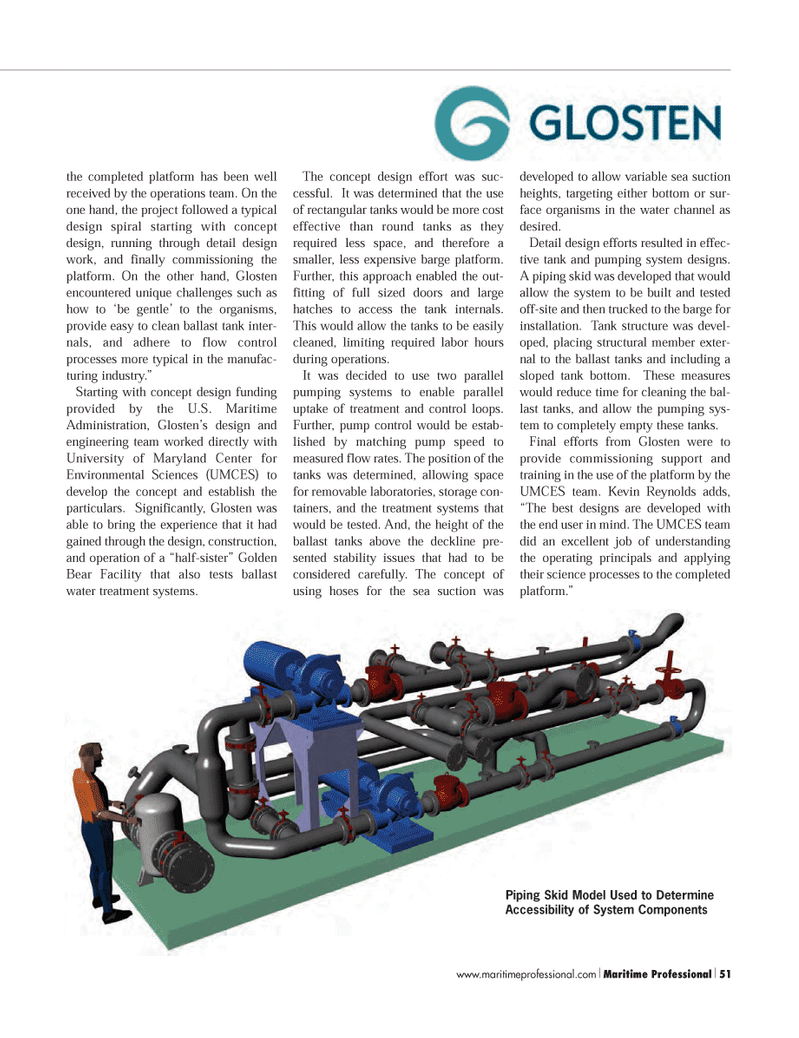
Page 51: of Maritime Logistics Professional Magazine (Q4 2011)
Classification
Read this page in Pdf, Flash or Html5 edition of Q4 2011 Maritime Logistics Professional Magazine
www.maritimeprofessional.com Maritime Professional 51 the completed platform has been wellreceived by the operations team. On the one hand, the project followed a typical design spiral starting with conceptdesign, running through detail designwork, and finally commissioning the platform. On the other hand, Glostenencountered unique challenges such ashow to ?be gentle? to the organisms, provide easy to clean ballast tank inter- nals, and adhere to flow control processes more typical in the manufac- turing industry.? Starting with concept design fundingprovided by the U.S. Maritime Administration, Glosten?s design and engineering team worked directly with University of Maryland Center for Environmental Sciences (UMCES) to develop the concept and establish the particulars. Significantly, Glosten was able to bring the experience that it had gained through the design, construction,and operation of a ?half-sister? GoldenBear Facility that also tests ballast water treatment systems. The concept design effort was suc- cessful. It was determined that the use of rectangular tanks would be more cost effective than round tanks as they required less space, and therefore asmaller, less expensive barge platform. Further, this approach enabled the out- fitting of full sized doors and large hatches to access the tank internals.This would allow the tanks to be easily cleaned, limiting required labor hoursduring operations. It was decided to use two parallel pumping systems to enable paralleluptake of treatment and control loops. Further, pump control would be estab- lished by matching pump speed tomeasured flow rates. The position of the tanks was determined, allowing space for removable laboratories, storage con- tainers, and the treatment systems thatwould be tested. And, the height of the ballast tanks above the deckline pre- sented stability issues that had to beconsidered carefully. The concept of using hoses for the sea suction was developed to allow variable sea suction heights, targeting either bottom or sur- face organisms in the water channel as desired.Detail design efforts resulted in effec- tive tank and pumping system designs. A piping skid was developed that would allow the system to be built and tested off-site and then trucked to the barge for installation. Tank structure was devel- oped, placing structural member exter- nal to the ballast tanks and including asloped tank bottom. These measures would reduce time for cleaning the bal- last tanks, and allow the pumping sys- tem to completely empty these tanks.Final efforts from Glosten were to provide commissioning support and training in the use of the platform by theUMCES team. Kevin Reynolds adds, ?The best designs are developed with the end user in mind. The UMCES team did an excellent job of understanding the operating principals and applyingtheir science processes to the completedplatform.? Piping Skid Model Used to DetermineAccessibility of System ComponentsMP #4 (50-64):MP Layouts 11/8/2011 2:27 PM Page 51

 50
50

 52
52
